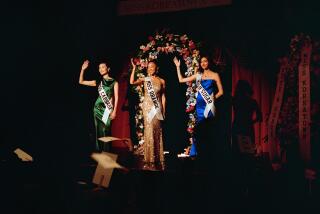Dreams Fit for a Queen : Neither feminism nor recession can diminish the lure of beauty pageants. There is something about a runway that’s hard for many to resist.
- Share via
Twenty-four young women in white shorts, red tops and white high heels rehearse a musical number in the lunchroom of Shively Elementary School. The dance begins well enough but soon deteriorates into a mess of missteps, confusion and laughter.
“Girls!”
The voice comes from choreographer Lynne Ashway.
“We have one more week to pageant,” she says in the slow but forceful tone of a fifth-grade teacher--which she is. “It’s getting kind of panicky, isn’t it? If it doesn’t get better than this, I’m going to scrap the whole dance number.”
The group looks sheepish and begins again, this time missing fewer steps.
Miss America this isn’t.
It’s the Miss Friendly El Monte-South El Monte pageant, a 39-year-old nonprofit event that will decide in 2 1/2 hours which young woman will best represent the two cities for a year.
The pageant will take place in the El Monte High School auditorium, its stage decorated with cutouts of carhops and foil-wrapped potted plants, carrying out the ‘50s theme “Juke Box Saturday Night.” The TV-ready world of living Barbie dolls wearing swimsuits stuck on with spray adhesive is light-years away.
Neither feminism nor recessions nor changing demographics can stop this tradition of showcasing perky, bright, attractive girls who want to stride down a runway wearing a crown.
The latest edition of the International Directory of Pageants is 454 pages of listings on international, national, state and local pageants, from Miss Rhododendron to Ms. Black Expo to Miss Ideal Teen to Ponchatoula Strawberry Festival Queen.
Pageants are everywhere, and they’re not going away.
Ted Cohen, the directory’s publisher and a veteran pageant director and judge, chalks that up, in part, to economics: Pageants can be lucrative.
But Cohen notes another factor in pageants’ popularity: the perennial appeal of pretty girls and women. “I don’t deny the fact,” he admits, “that I love to look at beautiful girls.”
But don’t call Miss Friendly El Monte-South El Monte a beauty pageant.
“These girls are chosen more on their scholastic achievements, it’s not a beauty pageant,” says pageant president Helen Thurston, who works with a board of directors. Her daughter, Jackie Jo Thurston Rowe, was crowned in 1988.
The list of entry requirements is short: Female; age 17 to 25; lives, works or attends school in one of the two cities; a minimum C average; never married; never given birth.
Thurston quickly points out this pageant’s perks: Each contestant is assigned a local sponsor who pays her expenses; the queen and runner-up princesses may keep their crown and tiaras; the contestants’ identical black-and-fuchsia gowns and floral-print swimsuits rule out any fashion advantages.
“When my daughter got married,” Thurston says, “she wore her crown with her veil. It was really beautiful.”
*
I think peoples’ idea of pageants are like Miss USA or Miss Universe, and they watch that on TV and the media somehow makes a really big deal out of those pageants. People sometimes misjudge (pageants) because they’re not empathetic enough to see that a lot of hard work goes into it. It doesn’t just take beauty to participate. I think a lot of people haven’t been able to experience the pressure of being up on stage and being asked questions under all that pressure. --Marie Lanoy, 19, contestant
*
After a two-hour rehearsal the contestants want to go home, but Ashway keeps them for one more run-through.
Most of them are high school seniors, a handful are in college. Tall, short, thin, hippy, busty, poised, gawky: This chorus line of teen-agers is proof that beauty has no single definition.
They practice their gown walk--a slow, steady gait. Smiling, turning, smiling, posing, smiling.
They rehearse their opening promenade, arms swinging, still smiling.
“C’mon, look alive, girls!” Ashway coaxes from the sidelines.
They recite their brief introductory speeches, each in a costume depicting a personality or trend from the ‘50s--Sandra Dee, poodle skirts, the twist, Connie Stevens, drive-in restaurants, TV Westerns, James Dean, Marilyn Monroe, pep rallies.
“ ‘Rock Around the Clock’ was first sung by Bill Haley and His Comets. . . .”
“Back in the 1950s, drive-in restaurants were very popular. We had very own drive-in restaurant here in El Monte. . . .”
“Although (Sandra Dee) was seen as the girl next door, (she) was secretly anorexic and bulimic. . . .”
Ashway reminds the young women to speak up, speak slowly, and admonishes them to memorize their speeches.
“All of you need to work on your speeches,” she says. “There was not one single solitary polished speech. The closer the pageant gets, the faster the time goes.”
*
Why do I do this? I think it’s the change I see in the girls. This really helps their self-esteem, and I’m not just talking about winning. To get on stage, whether you win or not, makes you feel like you’ve accomplished something. Maybe they won’t feel it that night, but I know they do, because we get some girls coming back and trying again the next year. --Lynne Ashway, choreographer and training director
*
A week later, on Dec. 11, the contestants fly through the backstage door lugging costumes and oversize makeup cases, their faces already slathered with foundation, blush and lipstick.
Dress rehearsal the previous night ran from 5 p.m. to 11:30 p.m., with a dinner break of spaghetti, salad, ice cream and chocolate cake. Few of the girls had a restful night.
“What time is it?” someone in one of two dressing rooms asks every five minutes.
“I’m not nervous, but, like, I just wanna get out there and go ,” says Shannon Musee, dressed as Connie Stevens in white capri leggings, a Hawaiian shirt and straw hat.
Fifteen minutes before curtain, an aura of mild panic takes hold in the dressing rooms.
“Where are my earrings ?”
“I messed up my eye makeup!”
“Does anyone have a gold chain? You guys?”
“Oh my God, I lost my shoe !”
Contestant Lisa Carrillo takes out a small tub of Vaseline and shows it to her sister, Linda, who was the 1993 Miss Friendly El Monte. She’ll make her farewell appearance tonight.
“How do I use this?” Lisa asks.
“Put a little on your front teeth like this,” Linda says, demonstrating. “When you smile a lot, your mouth gets really dry and then your lips will stick.”
Half a dozen others dive for the Vaseline, spreading it over their teeth and smiling into the mirror. One applies too much, makes a face and spits it out.
*
When I was young, there was a friend of ours named Max Shapiro, who is a former mayor of South El Monte. My mom was a single parent and we didn’t have the great clothes that other kids had. Max (befriended) my mom and helped her get a job . . . and one year he invited us to a pageant. I was, like, 11 years old, and it was just so beautiful to me looking at the girls up on stage, with smiles on their faces and crowns on their heads. And ever since then I’ve wanted to be queen. I can remember when I was 15 I said, “Can’t I lie and say I’m 17?”
--Yvette Lopez, 21, Miss Friendly El Monte-South El Monte 1992
*
“Dude! I can’t believe it! I ran right into the bushes!”
Monica Ponce enters the dressing room laughing, recounting her encounter with a potted plant during her swimsuit walk.
“I just turned around and went clunk . I’ll remember that for the rest of my life.”
Flor Torres says she’s been smiling so much that her facial muscles are starting to twitch.
The night’s few glitch-ettes are endearing rather than ruinous. Natalie Navarro nearly runs onstage in her evening gown, pumps and white athletic socks until another contestant yells, “Natalie, your socks! “
But the dance number is flawless.
“Yesssss!” Ashway shouts when it ends.
A pageant official walks through the backstage chaos of two dozen young women changing clothes, running through the hall trying to make cues and spraying thick clouds of Aqua Net.
“I’m glad I had boys,” she says, shaking her head.
*
I never tell anybody about the competition. I don’t want people thinking I’m bragging. Plus, some people don’t know me in this perspective. I’m in a school where there are feminists who don’t approve of pageants, they think they’re selling girls and their beauty. A lot of people don’t approve of them. I’m in an ethnic studies class, and one of our topics is why girls are in pageants and not men. I don’t think people know what they’re about. (The judges) ask you questions on certain issues and they want to see how well you answer. It has nothing to do with beauty, it’s about speaking your mind. --Flor Torres, 19, contestant
*
If the girls were nervous before, now they are in a state of highest anxiety.
The emcees are about to announce the 12 semifinalists. All the contestants, dressed in evening gowns, assemble on stage in a V-formation. The semifinalists step forward after their names are called, and the curtain closes on the remaining dozen.
Ashway watches from the wings.
“This is the hardest part.”
The girls embrace, some crying, maybe from sadness, maybe from sheer relief of the pressure.
“I’m just glad I was in it,” announces Shannon Musee.
In front of the curtain, each of the semifinalists must define a word from a list they were given weeks ago--words like friendship, loyalty, patriotism, responsibility, charisma.
“Pride. Pride to me means someone with their head up, ready to go, just . . . ready.”
“Each American needs patriotism to be . . . an American.”
“A friend is someone who’s there for me no matter what, who won’t let me down.”
Finally, the judges announce the scholarships and special prizes. Torres receives Miss Photogenic and Best Costume, Marie Lanoy wins Miss Congeniality, Lisa Carrillo gets the People’s Choice award.
Then, the four runners-up: Wendy Myring, Annette Reyes, Delia Rodriguez, Flor Torres.
The tension is palpable. The emcee pauses, then announces the winner: Lisa Carrillo. The audience erupts in applause.
Her sister pins the crown on Lisa, and a white-trimmed red cape is placed on her shoulders before she takes her celebratory ramp walk.
The stage quickly fills with family members bearing cameras and flowers for their daughters, sisters and girlfriends.
“You asked me why do I do this?” Ashway says, smiling as she surveys the mob scene. “This is why.”
More to Read
The biggest entertainment stories
Get our big stories about Hollywood, film, television, music, arts, culture and more right in your inbox as soon as they publish.
You may occasionally receive promotional content from the Los Angeles Times.










